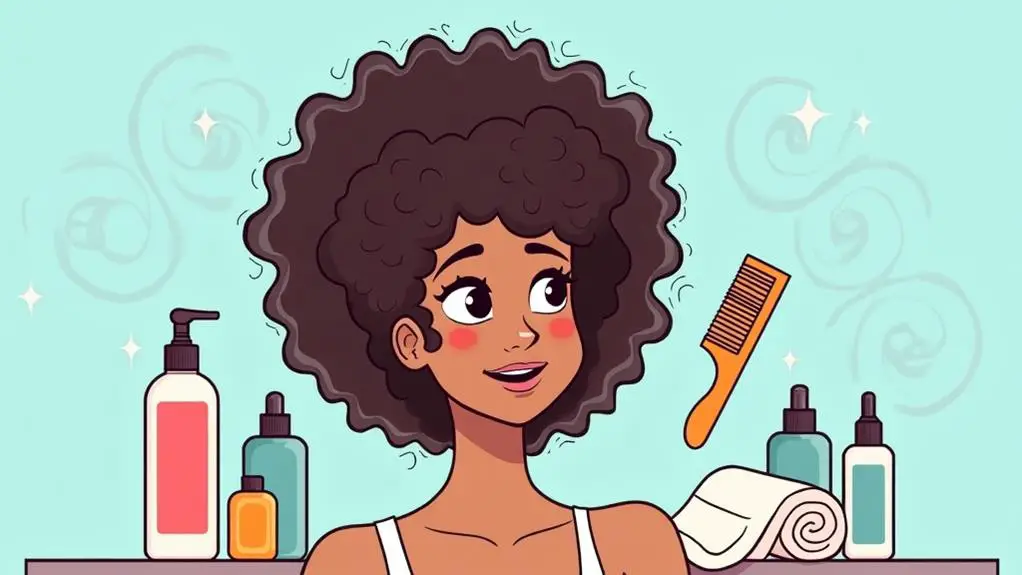You've spent years fighting your curls, trying to tame them into submission, but now you're ready to embrace their unique beauty. On the other hand, you're probably tired of dealing with frizz, tangles, and unmanageable locks. The truth is, curly hair requires a different kind of care, one that understands its distinct needs and nuances. By learning how to work with your curls, rather than against them, you can access a world of definition, bounce, and effortless style. But where do you start?
Key Takeaways
- Master your curl type by understanding your hair's natural texture, shape, and pattern to choose the right products and styling techniques.
- Select curl-friendly products that cater to your specific curl type, and layer them from lightest to heaviest for optimal results.
- Gentle cleansing methods, such as using sulfate-free shampoos, prioritize moisture retention and help prevent dryness and damage.
- Moisturizing deep conditioning treatments help repair and restore curls, leaving them soft, supple, and manageable.
- Protect your curls at night by switching to a silk pillowcase and wearing a satin bonnet to reduce friction and prevent tangles.
Understanding Your Curl Type
Before diving into the world of curly hair care, mastering your unique curl type is crucial.
You'll need to understand your curl pattern, which is influenced by your genetic makeup. Genetic influence plays a significant role in determining your curl type, with multiple genes controlling the texture, shape, and pattern of your hair.
To begin your curl pattern analysis, start by examining your hair's natural texture.
Is it tightly coiled, loosely wavy, or somewhere in between?
Next, identify your curl shape, which can range from tight spirals to loose "S" patterns.
Consider the porosity, density, and elasticity of your hair as well, as these factors will impact how your hair responds to different products and styling techniques.
Choosing the Right Products
With your curl type firmly in mind, you're ready to build a product arsenal that'll help you achieve the healthiest, most vibrant curls possible.
When selecting products, consider the specific curly hair concerns you're trying to address, such as dryness, frizz, or definition. Look for products that cater to your curl type, whether it's 2A, 3B, or 4C.
Product layering is key to achieving the perfect curl.
Start with a leave-in conditioner or moisturizer to hydrate your curls, followed by a styling product to enhance definition and texture.
For added hold and protection, apply a curl activator or styling cream.
Be mindful of the order in which you apply products, as this can affect how they interact with your curls.
Generally, it's best to apply products from lightest to heaviest, allowing each layer to absorb before adding the next.
Cleansing and Conditioning Tips
When you wash your curly hair, you'll want to adopt gentle cleansing methods that preserve your hair's natural oils and prevent stripping.
This means using a sulfate-free shampoo and avoiding harsh scrubbing or rubbing motions that can lead to breakage.
Gentle Cleansing Methods
About 70% of curly-haired individuals struggle with dryness, mainly due to harsh cleansing methods. To combat this, it is crucial to adopt gentle cleansing methods that prioritize moisture retention. You can start by choosing curl-friendly shampoos that are sulfate-free or contain gentle sulfates like sodium lauryl sulfoacetate.
| Shampoo Type | Key Ingredients | Benefits |
|---|---|---|
| Sulfate-free shampoo | Coconut-derived cleansers, olive oil | Gentle, non-stripping, and moisturizing |
| Gentle sulfate shampoo | Sodium lauryl sulfoacetate, glycerin | Cleanses without drying, adds moisture |
| Low-poo shampoo | Mild surfactants, panthenol | Cleanses without stripping, adds shine |
| Co-wash shampoo | Conditioner-based cleanser, aloe vera | Gentle, moisturizing, and defines curls |
When washing your curls, use a gentle massaging motion, working from scalp to ends. Avoid using hot water, as it can strip your hair of its natural oils. Instead, opt for warm water, and follow up with a cool water rinse to lock in moisture. By adopting these gentle cleansing methods, you'll be on your way to healthier, more vibrant curls.
Moisturizing Deep Conditioning
You've mastered gentle cleansing methods, now it's time to take your curl care to the next level with moisturizing deep conditioning.
This essential step helps to repair and restore your curls, leaving them soft, supple, and manageable.
When it comes to moisturizing deep conditioning, there are a few key things to keep in mind.
Initially, choose the right treatment for your curls:
- Hydrating masks for dry, thirsty curls
- Protein treatments for damaged, brittle curls
- Balanced treatments for normal, healthy curls
Depending on your curl type and needs, you can choose from a variety of treatments.
Look for products containing nourishing ingredients like coconut oil, shea butter, and argan oil.
Apply the treatment to your curls after shampooing, and leave it on for at least 15-30 minutes.
You can even leave it on overnight for an intense moisturizing boost.
Remember to follow the instructions carefully, and rinse your curls thoroughly to avoid any buildup.
With regular moisturizing deep conditioning, you'll be on your way to achieving healthy, vibrant curls that shine with life.
Styling for Definition and Bounce
Tackle styling for definition and bounce by first understanding the importance of moisture in curly hair.
Moisture is the foundation of curly hair routines, as it helps define curls and adds bounce. When your curls are well-moisturized, they're more receptive to styling techniques that enhance definition and bounce.
To achieve definition, focus on styling techniques that encourage curl clumping.
Use a curl activator or a leave-in conditioner to enhance curl definition. Apply these products to your curls in sections, working from the ends up. This helps to create defined curl clusters.
For added bounce, use a microfiber towel or an old t-shirt to blot excess water from your curls before applying styling products. This helps reduce frizz and enhances curl elasticity.
When choosing styling products, look for those that contain ingredients like beeswax, coconut oil, or shea butter.
These ingredients help lock in moisture, define curls, and add bounce. Remember to use a light hand when applying products, as too much can weigh your curls down and reduce definition.
Managing Frizz and Flyaways
Your curly locks' arch nemesis is frizz, which can quickly turn a beautiful, bouncy curl into a puffy, unmanageable mess.
Frizz fighting techniques are essential to maintaining definition and preventing your curls from looking lackluster.
One of the primary causes of frizz is humidity, so it's vital to develop humidity control strategies.
To combat frizz, you should:
1. Use a humidity-fighting serum: These lightweight serums create a barrier between your curls and the humid air, preventing moisture from penetrating the hair shaft and causing frizz.
2. Air-dry or diffuse: Avoid using hot tools like blow dryers, which can strip your hair of its natural oils and cause frizz.
Instead, air-dry or use a diffuser to enhance curl definition and reduce frizz.
3. Keep your curls moisturized: Use a hydrating curl activator or moisturizing mask to keep your curls hydrated and supple, making them less prone to frizz.
Protecting Your Curls at Night
As you drift off to sleep, your curls are still hard at work, vulnerable to friction, tangles, and damage from rubbing against your pillowcase.
To minimize this damage, switch to a silk pillowcase, which reduces friction and prevents curls from getting crushed. Silk is gentler on your hair than cotton, allowing your curls to retain their natural oils and definition.
Another option is to wear a satin bonnet to bed.
Satin bonnets are designed to protect your curls from friction and tangles while you sleep. Look for a bonnet with a soft, smooth fabric that won't cause friction or absorb moisture from your hair. This is especially important for curly hair, which tends to be drier than straight hair.
Frequently Asked Questions
Can I Use Hot Tools on Curly Hair Without Damaging It?
You can use hot tools on curly hair without damaging it by applying curly hair protectants beforehand, but it's still risky; consider heatless styling methods like twist-outs or braid-outs instead to preserve your curls' integrity and prevent heat damage.
How Often Should I Trim My Curly Hair to Prevent Split Ends?
Imagine a majestic, untrimmed curly mane, resembling a tangled bird's nest – not a great look. You'll want to trim every 6-8 weeks to maintain a healthy, defined curl pattern, as curly hair tends to grow slower than straight hair, making regular trims vital.
Can I Use Regular Towels to Dry My Curly Hair?
When you step out of the shower, you're tempted to reach for a regular towel to dry your hair, but you shouldn't; instead, you'll want to opt for Microfiber alternatives, which allow for Gentle blotting that's gentler on your locks, reducing frizz and breakage.
Will Swimming in Chlorinated Water Damage My Curly Hair?
When you swim in chlorinated water, you're exposing your hair to harsh chemicals that can cause damage. Chlorine absorption and water penetration can lead to dryness, brittleness, and breakage, so be sure to take protective measures before diving in.
Can I Color My Curly Hair Without Causing Further Damage?
Oh, you want to dye your locks a million shades of fabulous? Go for it! But, please, for the love of all things curly, use color-safe products to preserve your vibrant tones and prevent further damage – your curls will thank you!
Conclusion
By embracing your unique curl type and adopting these expert-backed tips, you'll be well on your way to flaunting fabulous, healthy-looking locks. With gentle cleansing, nourishing conditioning, and clever styling tricks, your curls will thrive. Say goodbye to frizz and flyaways, and hello to defined, bouncy spirals that turn heads. By night, give your curls the TLC they deserve, and wake up to a hair-raising experience that's simply divine.














